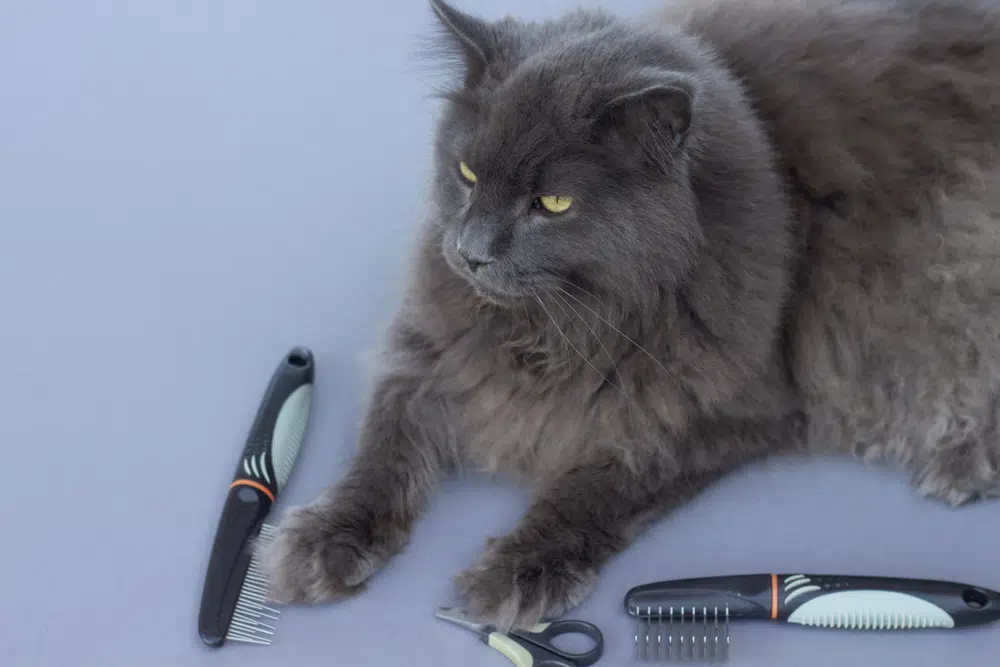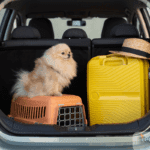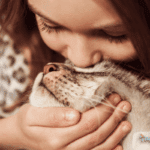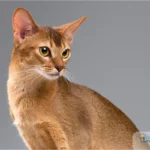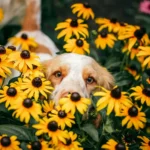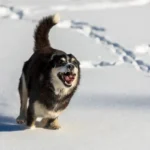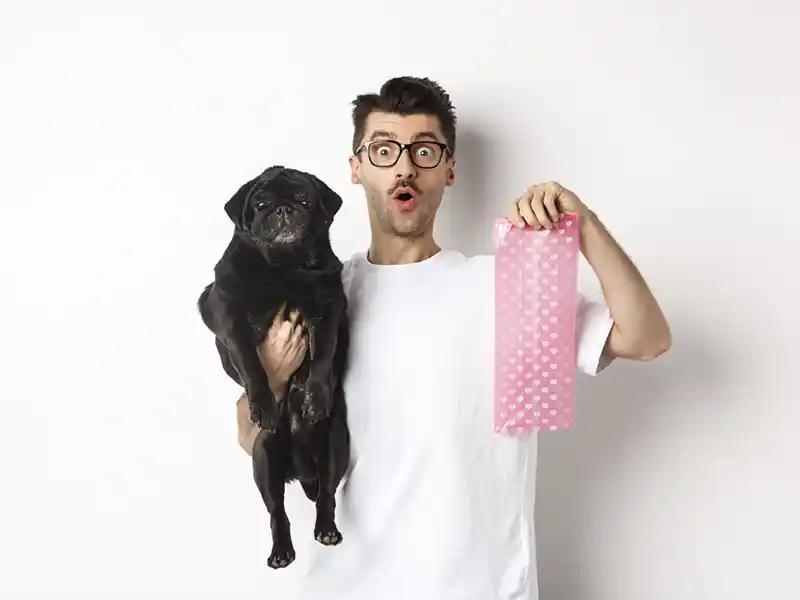Expert Grooming Tips
Maine Coons are adored for their majestic appearance, intelligent demeanor, and affectionate nature. Their thick, luxurious coat is one of their most striking features, but it also comes with unique grooming needs. Regular grooming isn’t just about keeping them looking beautiful—it’s essential for their health and happiness. This guide will walk you through everything you need to know to care for your Maine Coon like a pro.
Why Your Maine Coon Cat’s Coat Needs Special Care
Maine Coons are renowned for their impressive double coat, a unique combination of beauty and practicality. The outer layer, sleek and water-repellent, serves as a barrier against harsh weather, while the soft, dense undercoat provides insulation to keep them cozy in colder conditions. This intricate fur system not only showcases their majestic appearance but also makes them highly adaptable to various climates.
However, such a remarkable coat comes with responsibility—it requires consistent grooming to prevent tangles, reduce shedding, and demands special attention because:
- Prone to Matting: Without regular grooming, their dense undercoat can tangle and form painful mats.
- Seasonal Shedding: Maine Coons shed heavily during spring and fall, which can lead to hairballs if shedding is unmanaged.
- Coat Maintenance is Health Maintenance: Grooming helps keep their coat glossy and their skin healthy while allowing you to check for signs of underlying health problems.
During grooming, take the opportunity to inspect their skin for redness, bumps, or bald patches. These could signal dermatitis, fungal infections, or parasites that may require veterinary attention.
Dr. Esther Knoetze, BVSc, explaines: “Maine Coons are known for their thick double coats, which require routine brushing to prevent matting and promote healthy skin. Grooming also gives owners a chance to detect potential skin issues early.”
- • Gently part your cat’s fur in key areas such as the armpits, belly, and behind the ears.
- • You should be able to see their skin clearly
- • If you can’t or notice tangles, it’s time for a thorough brushing session.
💡 Extra Tip:
Maine Coons are known for their relaxed demeanor, but they still benefit from a calm, stress-free grooming environment. Set up a quiet space with soft lighting to create a positive experience for your cat. Need tips? Explore our Cat-Proofing Your Home Guide.
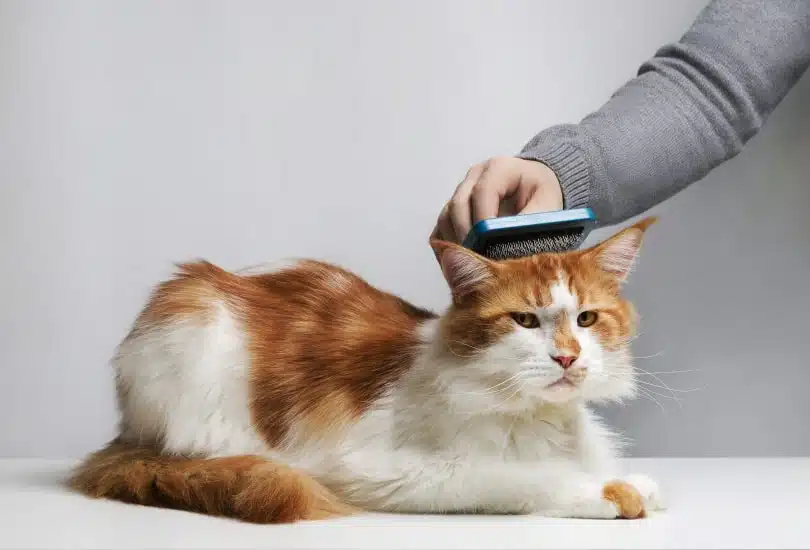
Your Essential Maine Coon Grooming Kit
Wide-toothed Metal Comb
- Why you need it: Essential for reaching deep into the dense undercoat to prevent mats and tangles.
- Look for: Stainless steel with 4-6 mm tooth spacing for effective grooming without pulling.
- Pro Tip: Stainless steel combs reduce static and glide smoothly through fur.
“A good comb helps detect fleas or ticks. Look for flea dirt (small black specs) at the base of the fur while combing.” – Dr. Esther Knoetze, (BSc)(BVSc).

Stainless Steel Pet Grooming Comb Set – Wide, Dense & Flea Tooth Combs (3 pack)
Made with premium stainless steel, round and gentle teeth for scratch proof, very durable and smooth. Effectively remove loose hair, dander & dirt trapped beneath fur.
Undercoat Rake
- Why you need it: Perfect for removing loose undercoat fur, this tool prevents matting and promotes healthy fur growth in thick-coated breeds like Maine Coons.
- Look for: Choose an undercoat rake with fine, rounded teeth to gently penetrate the dense undercoat without irritating your cat’s skin.
- Pro Tip: Opt for a rake with an ergonomic handle to reduce hand fatigue during longer grooming sessions.
“Regular use of an undercoat rake reduces shedding and minimizes hairball risks. It’s an essential tool for maintaining your cat’s coat health.” – Dr. Esther Knoetze, (BSc)(BVSc).

FURminator Dog/Cat Grooming Rake, Grooming Tool, Removes Loose Hair and Tangles, Gray
Removes loose hair, tangles and prevents mats
The rotating metal teeth help to remove loose hair from undercoat in dense fur
Best for dogs and cats with thick fur or dense double coats
Convenient daily solution for undercoat care
The ergonomic non-slip handle gives you maximum control
Slicker Brush
- Why you need it: Perfect for removing loose fur, reducing shedding, and detangling knots.
- Look for: Flexible bristles with rounded tips to protect your cat’s sensitive skin.
- Pro Tip: “Always brush in the direction of hair growth,” advises Dr. Esther Knoetze.
💡 Money-Saving Tip: Start with a wide-toothed comb and slicker brush—these tools cover about 80% of your grooming needs.

Hertzko Self-Cleaning Dog & Cat Slicker Brush
This brush gently removes loose hair and eliminates tangles, knots, dander, and trapped dirt. It features a comfortable grip and a self-cleaning function for easy maintenance.

Hepper Deshedding Cat Brush
ONE PUSH RELEASE – This kitten brush / cat brush pops out fur with just a simple press, leaving you…
DURABLE – Cat shedding can be a tough ordeal. Made of resilient ABS plastic and metal bristles with…
COMFORTABLE – A cat fur brush with 60 degree angled, fine bristles and rubber stoppers will bring…
Cat-Safe Shampoo
- Must be: pH balanced (6.5-7.5).
- Look for: Hypoallergenic formula free from artificial fragrances and harsh chemicals.
- Avoid: Human shampoos—they disrupt your cat’s skin pH balance.
“Maine Coons have a water-resistant coat, so over-bathing can strip natural oils. Consult your veterinarian for the ideal bathing frequency,” advises Dr. Esther Knoetze, (BSc)(BVSc).
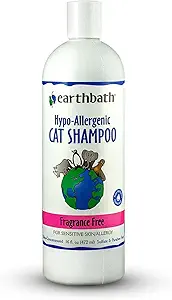
Hypoallergenic Cat Shampoo – Fragrance Free Cat Shampoo for Allergies and Itching, Made in USA
This fragrance-free, pH-balanced shampoo is designed for sensitive skin, ensuring a gentle and effective clean without irritating your cat’s skin.
Microfiber Towels (at least 2)
- Why: Ideal for quick-drying and gentle on your Maine Coon’s dense coat to prevent tangles.
- Pro Tip: “Pat your cat’s coat dry instead of rubbing to maintain the smooth texture of their fur,” shares Maria.
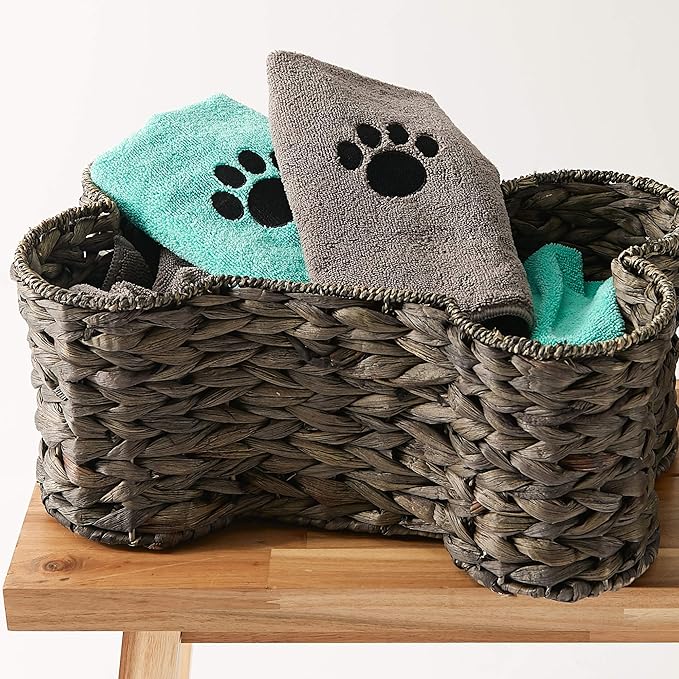
Bone Dry Pet Grooming Towel Collection Embroidered Absorbent Microfiber Drying Set, 15×30,
These absorbent microfiber towels are perfect for drying your cat efficiently while being gentle on their coat.
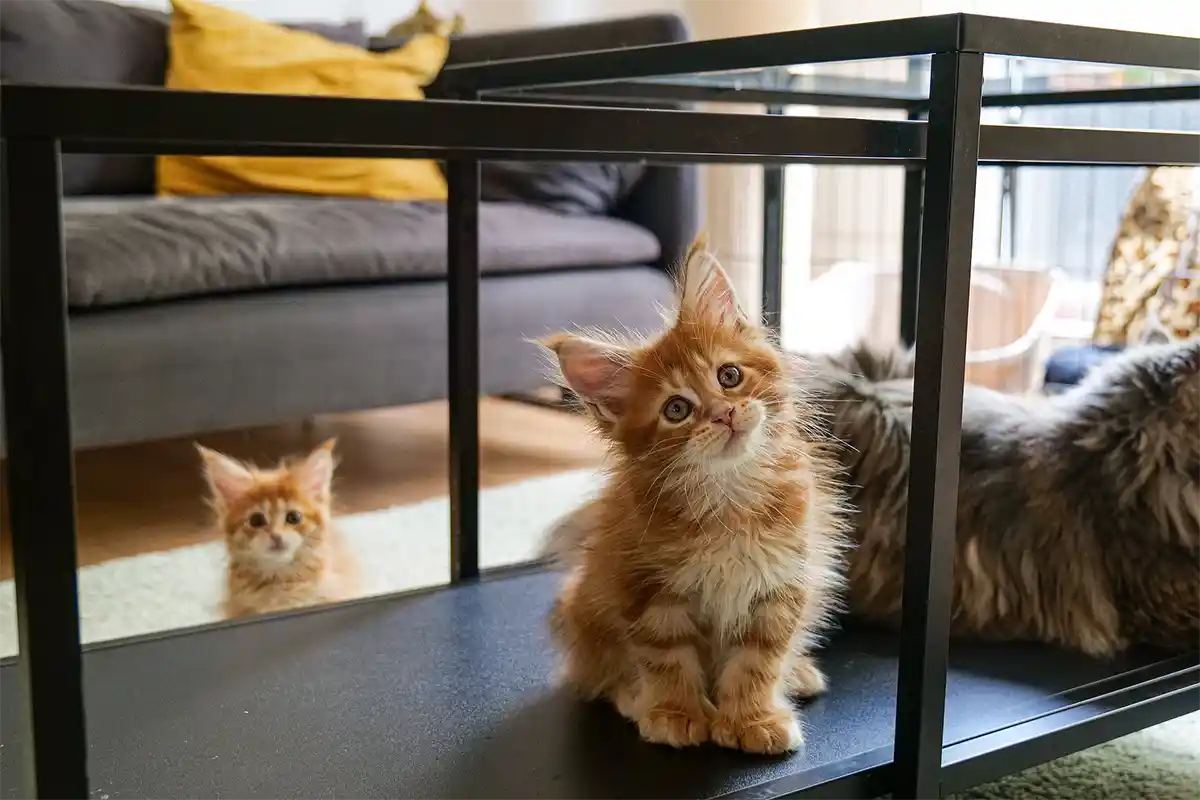
Tackling Common Grooming Challenges
1. Start Early
Maine Coons are known for their gentle and social nature, but introducing grooming at an early age is crucial to ensuring they are comfortable with the process. Whether they are kittens or adults, starting early fosters trust and builds grooming into a bonding activity.
- Kittens Adapt Quickly: Young Maine Coons are naturally curious and more open to new routines. Introduce grooming tools gently and reward with treats to create positive associations.
- Older Cats Need Time: For adult Maine Coons, patience is key. Start by familiarizing them with brushes and combs before full grooming sessions to minimize stress.
“Starting grooming early not only ensures a well-maintained coat but also helps in identifying early signs of skin issues or parasites.” – Dr. Esther Knoetze, (BSc) (BVSc).
New Maine Coon owner? Our Vet-Approved New Cat Supply Checklist will jump start you with trusted products.
2. Develop a Routine
Consistency is essential for maintaining your Maine Coon’s luxurious coat. A regular grooming schedule tailored to their needs prevents matting, minimizes shedding, and keeps your cat comfortable year-round.
- Seasonal Grooming: Maine Coons shed heavily in spring and fall. Increase brushing frequency during these times to control shedding and prevent hairballs.
- Adjust for Age: Older Maine Coons, particularly those with arthritis or mobility issues, may need extra assistance with grooming and hygiene.
💡 Pro Tip: “Brush daily during shedding seasons and twice weekly at other times to keep your Maine Coon’s coat manageable and healthy.”
3. Keep Sessions Fun
Make grooming a positive experience for your Maine Coon by incorporating play, treats, and praise into the routine.
- Shorter Sessions: Break grooming into smaller, manageable segments to prevent frustration.
- Stay Calm: Use a soothing tone and gentle strokes to make your cat feel safe and relaxed.
💡 Extra Tip: Use a non-slip mat on your grooming table and keep a favorite toy or treat nearby for added comfort.
4. Focus on Problem Areas First
Maine Coons have areas that are prone to matting, such as behind their ears, under the armpits, and along the tail. Address these first to ensure you tackle them before your cat becomes restless.
- Why Start Here? These areas often require more attention due to friction and tangling.
- Stress Reduction: Finish with areas your cat enjoys, such as the chin or back, to leave a positive impression.
💡 Pro Tip: “Use a detangling spray for stubborn knots, and always monitor the skin for signs of irritation or redness.”
5. Use a Variety of Brushes
The right tools are crucial for effective grooming. A well-equipped grooming kit helps manage Maine Coons benefit from a diverse grooming toolkit tailored to their thick double coat. Each tool serves a unique purpose in managing their fur efficiently.
- Wide-Toothed Combs: Perfect for detangling and removing loose hair from the undercoat.
- Slicker Brushes: Great for reducing shedding and reaching the dense undercoat.
- Rubber Brushes: Ideal for gentle grooming sessions, especially for kittens or sensitive areas.
💡 Pro Tip: “Start with a wide-toothed comb and finish with a slicker brush to manage tough mats and tangles.”
6. Can You Shave a Maine Coon Cat?
Is it a good idea to give your Maine Coon cat a haircut? While it’s technically possible, shaving is rarely necessary. Maine Coons boast a thick, water-resistant double coat that is both protective and functional. Regular brushing is usually sufficient to maintain their fur, but there are instances where trimming or shaving might be considered.
When Shaving Might Be Necessary:
- Severe Matting: If your Maine Coon’s coat becomes heavily tangled or matted, causing discomfort or pulling on their skin, shaving may be the safest solution.
- Hygiene Issues: Dirt, debris, or sticky substances embedded in the coat might require localized trimming or shaving.
- Medical Reasons: A veterinarian might recommend shaving for skin conditions, allergies, or surgical procedures.
Alternatives to Shaving:
Before reaching for clippers, consider these steps to address problem areas:
- Apply Coconut Oil: Dab a small amount onto the matted fur and let it sit for about an hour to loosen tangles.
- Use a De-Matting Comb: Gently work through knots to detangle the fur.
- Trim with Blunt-Ended Scissors: For persistent mats, carefully trim away small sections without cutting near the skin.
What to Keep in Mind if Shaving Is Necessary:
- Maine Coons as Indoor Cats: Their coat serves as insulation, so without it, they can be more sensitive to temperature extremes and sunburn.
- Seek Professional Help: If shaving becomes unavoidable, a certified groomer can ensure the process is stress-free and safe for your cat.
“Matted fur can cause significant discomfort and even lead to skin infections. If mats persist or spread, consult your vet or a certified groomer for the best course of action.” – Dr. Esther Knoetze, (BSc) (BVSc).
7. Battling the Dreaded Mats
Even with regular grooming, mats can form in high-friction areas. Preventing mats is key to keeping your Maine Coon comfortable.
Mat Danger Zones:
- Behind ears (high friction & heat).
- Under collars (prone to skin irritation).
- Armpits (moisture-prone areas).
- Groin area (sensitive skin).
- Base of tail (oil accumulation).
Dealing with Mats Safely:
- Small Tangles:
- Use a detangling spray and wait 2-3 minutes.
- Gently separate with fingers and comb through carefully.
- Stubborn Mats:
- Use a mat splitter, working from the edges inward.
- Take frequent breaks and avoid pulling to prevent skin trauma.
⛔ Medical Alert: Never use scissors near the skin or force a comb through a mat. Always seek professional help if mats are severe.
8. Managing Shedding Season
“Maine Coons shed year-round, but spring and fall are peak shedding seasons. Excessive shedding may signal health issues.” – Dr. Esther Knoetze, (BSc) (BVSc).
Prevention Strategies:
- Brush daily during peak shedding seasons.
- Incorporate omega fatty acids into their diet for a healthier coat.
- Schedule regular baths every 4-6 weeks.
- Monitor for bald patches or irritated skin.
Clean-Up Solutions:
- Keep lint rollers handy for quick furniture clean-ups.
- Invest in a high-quality vacuum to handle pet hair.
- Use washable furniture covers to simplify cleaning.
- Track shedding patterns to identify any irregularities.
🏥 When to Consult a Vet:
- Sudden increases in shedding.
- Visible bald spots.
- Persistent skin irritation or excessive scratching.
9. Use Positive Reinforcement
Maine Coons thrive on love and positive interactions. Rewarding your cat during and after grooming sessions can build trust and make the process enjoyable for both of you.
- Treats for Tolerance: Offer a favorite treat after brushing or trimming. It creates a positive association with grooming.
- Praise and Affection: Use soothing tones and praise to reinforce good behavior during grooming.
💡 Pro Tip: “Treats and praise after a tough session help associate grooming with positive outcomes, making future sessions easier and stress-free.”
10. Listen to Your Cat
Even the laid-back Maine Coon has limits. Paying attention to their body language ensures grooming remains a comfortable and positive experience.
- Recognize Discomfort: Overgroomed or irritated skin can make brushing painful. Switch to gentler tools if necessary.
- Adjust Techniques: If your cat shows signs of stress or discomfort, take a break or use a different brush.
💡 Extra Insight: “Listening to your cat ensures grooming is a bonding moment, not a battle.”
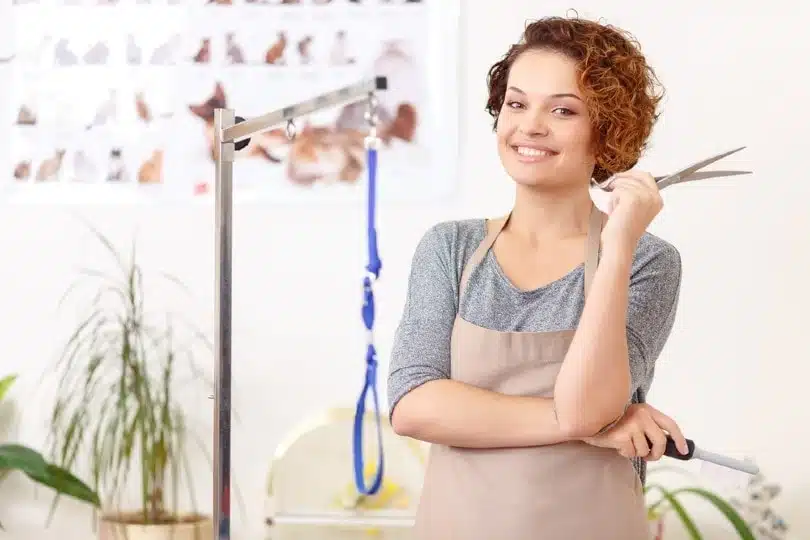
Professional Grooming & Health Checks
Signs It’s Time for Expert Help
- Severe matting.
- Persistent skin issues.
- Strong odors.
- Stressed cat or owner.
- Unexplained coat changes.
“If you notice persistent dandruff, thinning fur, or scabs, schedule a veterinary check-up to rule out underlying issues like allergies or fungal infections before proceeding with grooming.” – Dr. Esther Knoetze, (BSc) (BVSc).
Professional Service Expectations
⏱️ First visit: 2-3 hours (includes health assessment).
⏰ Regular visits: 1-2 hours.
💰 Cost: $50-$100 (varies by location).
📅 Frequency: Every 8-12 weeks for maintenance.
Must-Have Qualifications for Groomers
- Certified Feline Master Groomer (CFMG).
- Experience with Maine Coon cats.
- Clean, quiet facility.
- Current pet first aid certification.
- Relationship with a local vet clinic.
Seasonal Grooming Adaptations
Summer Care (20-30°C / 68-86°F) ☀️
- Increase brushing frequency.
- Watch for overheating during grooming.
- Consider a “summer cut” if needed.
- Use cooling mats during sessions.
Winter Care (15-20°C / 59-68°F) ❄️
- Monitor for dry skin.
- Use pet-safe moisturizing sprays.
- Keep indoor humidity balanced.
- Reduce bathing frequency.
“A humidifier can help combat dry air during winter, keeping your cat’s skin hydrated and comfortable. This reduces the risk of skin issues and static electricity in their coat.”
Emergency Grooming Situations: Quick Action Guide
Emergency Kit Essentials 🧰
- Vet and groomer emergency numbers.
- Pet-safe scissors (blunt-tipped).
- First aid supplies.
- Styptic powder.
- Cat carrier.
- Calming aids prescribed by your vet.
📌 Read More: “If you notice skin irritation or unexpected injuries, consult our Veterinarian’s Complete Cat Emergency Guide for critical care tips.”
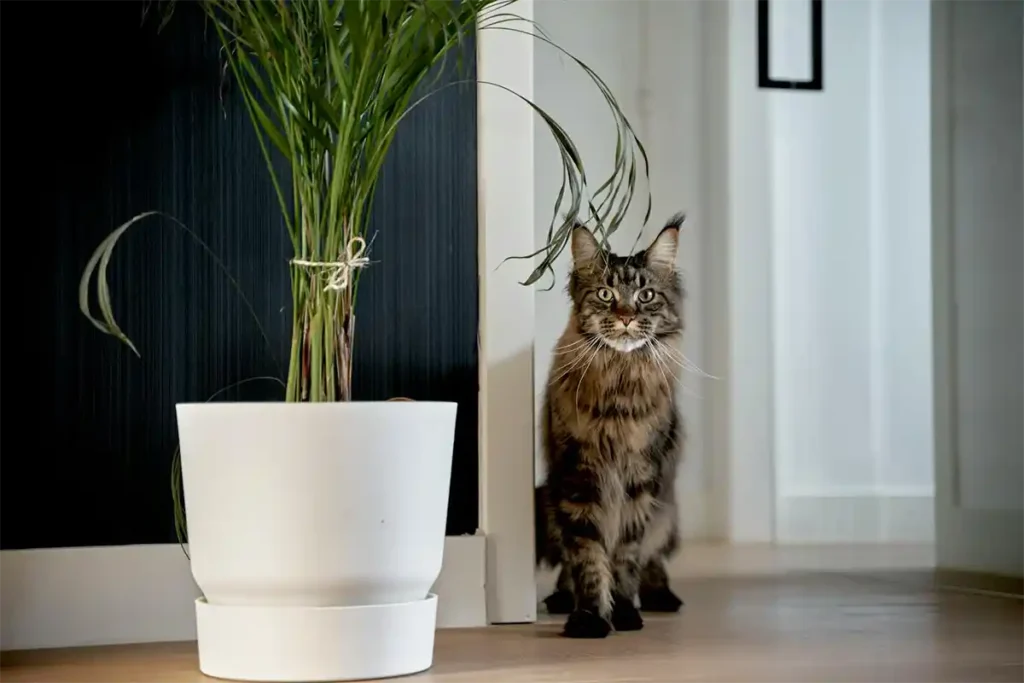
Brushing Techniques for Your Maine Coon
Brushing your Maine Coon isn’t just about maintaining their majestic coat—it’s an opportunity to bond with your feline friend while ensuring their comfort and health. Follow these expert tips to make every grooming session a stress-free pampering experience:
- Always Brush in the Direction of Hair Growth
Think of brushing as mimicking gentle petting. Start at the head and work your way down the back, sides, chest, and legs. Brushing against the grain can tug on fur, causing discomfort and potential matting.
- Start with the Undercoat Rake
Use long, sweeping strokes with an undercoat rake to remove loose fur trapped in the dense undercoat. This step helps prevent matting before it starts.
- Follow Up with a Slicker Brush
After clearing the undercoat, switch to a slicker brush. Use gentle strokes to remove debris and loose hair from the topcoat, leaving it smooth and polished.
- Handle Sensitive Areas with Care
Grooming spots like the belly, behind the ears, and near the tail requires a softer touch. Use a gentler brush and be extra patient to keep your cat comfortable.
- Focus on Matting Hotspots
Pay close attention to areas prone to tangles, such as the chest, armpits, and under the legs. Gently work out small tangles with your comb, using a detangling spray if needed.
Brushing Tips for Nervous Maine Coons
If your cat is nervous about brushing, here’s how to ease them into the routine:
- Start Slow: Begin with short sessions, just a few minutes at a time, and gradually increase the duration as your cat becomes more comfortable.
- Reward Good Behavior: Use treats and praise to make grooming a positive experience.
- After Playtime: Brush your Maine Coon after a play session when they’re more relaxed and receptive.
- Find the Perfect Spot: Groom in a calm, quiet area where your cat feels safe.
By following these techniques, brushing becomes more than a chore—it’s a bonding ritual that leaves your Maine Coon’s coat healthy, glossy, and tangle-free.
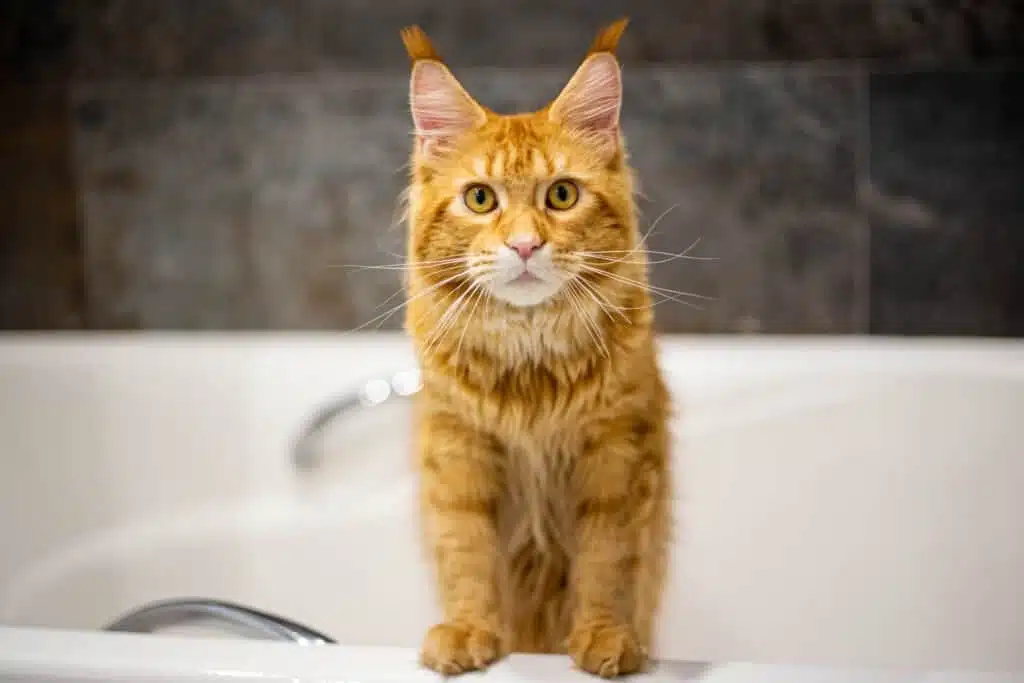
Bathing Your Maine Coon: Royal Spa Experience
While Maine Coons are skilled self-groomers, there are times when a bath is the perfect solution for keeping them fresh and clean. Think of bathing as a spa day for your regal feline, reserved for special occasions like a muddy mishap or an oily coat.
When to Bathe Your Maine Coon
- After a Messy Adventure: If your Maine Coon has rolled in something unpleasant or muddy, a bath will restore their royal elegance.
- Oily Fur: An overly greasy coat may require a refreshing cleanse to remove buildup and maintain its natural shine.
Bathing Basics
Transform bath time into a stress-free ritual with these essential tips:
- Use Lukewarm Water: Avoid hot water, which can dry out your Maine Coon’s sensitive skin. Tepid water keeps them comfortable during their bath.
- Choose Cat-Specific Shampoo and Conditioner: Never use human products. Opt for gentle, pH-balanced cat shampoos and conditioners to protect their skin and enhance their coat.
- Massage, Don’t Scrub: Apply shampoo with a gentle massaging motion, avoiding their face and ears. Rinse thoroughly to remove all product residue.
- Optional Conditioning: A cat-safe conditioner can nourish your Maine Coon’s fur, making it easier to detangle and leaving a healthy, glossy finish.
Drying Your Maine Coon After a Bath
- Towel Dry First: Wrap your cat in a soft, absorbent towel to remove as much moisture as possible. Gently pat them dry instead of rubbing, which can cause tangles.
- Blow Drying: Proceed with Caution
- Low Heat and Distance: If your cat tolerates it, use the lowest heat setting on a blow dryer and keep it at a safe distance to avoid discomfort.
- Monitor Their Comfort: If your cat becomes anxious, switch to towel drying immediately.
- Blow-Drying Tents: For a modern solution, consider a cat blow-drying tent. These provide gentle airflow, minimizing stress while speeding up drying. Ensure your cat can exit the tent freely if they feel overwhelmed.
By mastering these brushing and bathing techniques, you can ensure your Maine Coon stays comfortable, healthy, and as majestic as ever. Grooming doesn’t just enhance their coat—it strengthens your bond, turning every session into a special moment of connection.
Maine Coon Grooming FAQs
By addressing these frequently asked questions, we aim to simplify your Maine Coon grooming journey and ensure your gentle giant stays happy and healthy.
1. How often should I groom my Maine Coon cat?
+Maine Coons have dense, luxurious coats that require consistent care to keep them healthy and tangle-free.
- Recommendation: Brush your Maine Coon 2-3 times a week to prevent matting and minimize shedding
- Shedding Season: Increase grooming sessions to daily during spring and fall to manage heavy shedding and reduce hairballs
🩺 Veterinary Insight:
“Regular grooming not only keeps your Maine Coon’s coat in top condition but also strengthens the bond between you and your cat.” – Dr. Esther Knoetze, (BSc)(BVSc).
2. What tools are best for grooming a Maine Coon cat?
+A well-stocked grooming kit is essential for maintaining your Maine Coon’s thick double coat.
- Wide-Toothed Comb: Reaches through the undercoat and effectively detangles
- Slicker Brush: Removes loose fur and prevents mats
- Rubber Brush: Gently removes shed fur from sensitive areas
- Grooming Gloves: Perfect for a soothing grooming experience and massaging the undercoat
3. Can I bathe my Maine Coon cat?
+Bathing is rarely necessary for Maine Coons, as their coat is naturally water-resistant and self-cleaning. However, occasional baths can help in certain situations.
- When to Bathe: If your cat becomes excessively dirty or has a skin condition
- How to Bathe: Use a pH-balanced, hypoallergenic cat shampoo with lukewarm water
- Aftercare: Dry thoroughly with a microfiber towel to prevent chills
🐾 Tailwaggors Tip:
Overbathing can strip natural oils from their coat, so consult your vet to determine the right bathing frequency.
4. How can I prevent my Maine Coon’s fur from matting?
+Regular brushing is the best way to prevent mats and keep your Maine Coon comfortable.
- Focus Areas: Behind the ears, under the legs, and near the tail—common spots where tangles form
- Dealing with Mats: Use a detangling spray and gently comb out knots. For severe mats, seek help from a professional groomer
🩺 Veterinary Insight:
“Matted fur can lead to discomfort and even skin infections if left untreated.” – Dr. Esther Knoetze, (BSc)(BVSc).
5. Do Maine Coon cats shed a lot?
+Yes, Maine Coons shed year-round, with heavier shedding during spring and fall.
- Management Tips: Regular brushing and a diet enriched with omega-3 fatty acids help control shedding
- Proactive Care: Keep lint rollers, washable furniture covers, and a pet hair vacuum handy to manage fur in your home
6. Should I trim my Maine Coon cat’s nails?
+Yes, regular nail trims are essential to prevent overgrowth and potential injuries.
- Frequency: Trim every 2-3 weeks
- How To: Use cat-specific nail clippers and avoid cutting the quick (the sensitive part of the nail)
🐾 Tailwaggors Tip:
If you’re unsure how to trim your cat’s nails, ask your vet or a professional groomer for guidance.
7. How can I make grooming a positive experience for my Maine Coon?
+Maine Coons are intelligent and social cats, making them receptive to positive grooming experiences.
- Start Early: Introduce grooming tools during kittenhood to build familiarity
- Positive Reinforcement: Use treats, toys, and praise to create positive associations
- Short Sessions: Begin with brief grooming sessions and gradually increase their length
- Calm Environment: Groom in a quiet, stress-free space to keep your cat relaxed
🩺 Veterinary Insight:
“Patience and encouragement can turn grooming into a bonding activity your Maine Coon looks forward to.” – Dr. Esther Knoetze, (BSc)(BVSc).
8. When should I seek professional grooming services for my Maine Coon?
+Professional grooming may be necessary in specific situations:
- Severe matting that cannot be safely removed at home
- Visible skin irritation, infections, or wounds
- Difficulty with nail trimming or bathing
🩺 Veterinary Insight:
“Certified groomers have the tools and expertise to handle complex grooming needs safely.” – Dr. Esther Knoetze, (BSc)(BVSc).
9. How can I care for my Maine Coon’s teeth and ears?
+Oral and ear hygiene are key components of your cat’s overall health.
- Teeth: Brush regularly with a cat-specific toothbrush and toothpaste to prevent tartar buildup and dental issues
- Ears: Check weekly for dirt or signs of infection, and clean gently with a vet-approved ear cleaner
🐾 Tailwaggors Tip:
Healthy teeth and clean ears contribute significantly to your Maine Coon’s overall well-being.
10. Is it necessary to trim my Maine Coon’s fur?
+Routine haircuts are typically unnecessary, but occasional trims may be needed in specific cases:
- When Needed: Severe matting, hygiene concerns, or medical reasons
- Professional Help: Always consult a professional groomer to ensure safe and effective trimming
🐾 Tailwaggors Tip:
With regular brushing, your Maine Coon’s coat remains manageable, making trims unnecessary for most cats.
Final Words of Encouragement
Proper grooming is more than just aesthetics – it’s a crucial part of your Maine Coon’s health care routine. Your dedication to learning proper grooming shows how much you love your cat. Take it one day at a time, celebrate small victories, and know that our community, including veterinary experts, is here to support you.
⭐ Your Next Steps:
- Go through our beginner’s checklist
- Start with just 5 minutes daily
- Share your journey with us! Contact Tailwaggors
🐾 Obsessed with Maine Coon cats? Us too! 🐱
Share this guide with your fellow Maine Coon cat enthusiasts and help them uncover the secrets to keeping their feline friends looking fabulous and feeling great! 🧴✨
📩 Spread the purr-fect care tips today!


